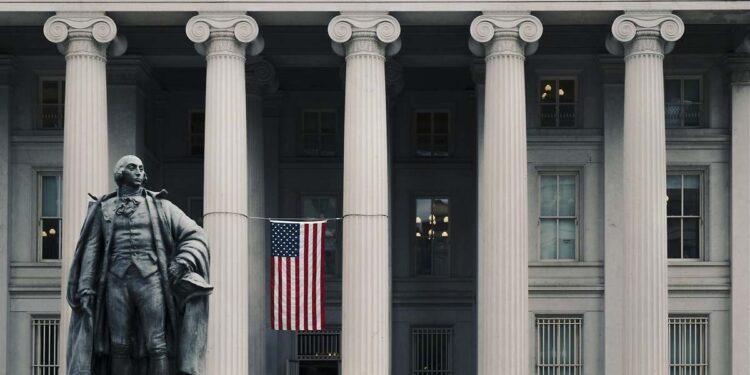An important risk could trigger tensions and force the Federal Reserve to take action: the Income Tax Declaration. In the US the period is open for all citizens and businesses to carry out this procedure, the deadline closes between April 15 and 17. Analysts are already warning that there is a significant and underestimated risk that US firms may request that, due to this process, hundreds of billions of dollars leave the financial system in a very short period of time, putting pressure on bank reserves below a key level that would force the Fed to act.
This situation is not new, in fact, it already happened in 2019. Back then, market interest rates for repos shot up to 10%, catching everyone by surprise. The ‘repos’ market is a mechanism by which financial institutions (and other companies) park their excess liquidity at the end of the day in exchange for an interest rate. What happened was that bank cash fell very quickly because companies had to face tax payments before the due date (September 16), just at the same time as there was a large issuance of treasury bonds. There was a rapid process of draining liquidity from the financial system. The banks were left dry.
The Federal Reserve itself explained in a report a year later, analyzing the reasons for this strange situation that “the major stresses of September 2019 stemmed from a reduction in reserves due to bonds in circulation at their highest level ever“. At the same time, the institution points out that “uncertainty about cash flows contributed to banks’ reluctance to increase loans (given the higher interest rates in the repo market)”.
The coincidence of these two events caused minimum bank liquidity levels to fall below the required levels, forcing the Federal Reserve to inject $75 billion in a single day and repeat this process for an entire week. In addition, the Federal Reserve bought $60 billion in treasury bonds to stabilize the market in response to this crisis. “These actions succeeded in calming the markets and alleviating the pressures”, the Fed explains. However, some of those factors may be present today and, although not to the same extent, some believe that tensions may arise again.
In any case, analysts are not talking about widespread chaos, but they acknowledge that there could be a high degree of agitation. Firstly, the banks already have low reserves in the Reserves market, something explained by Teresa Ho Kim, JP Morgan analyst, in statements to Bloomberg. “We are close to the lowest level and liquidity is being withdrawn from the system in a potentially problematic dynamic”.
Near Drought Levels
Bank reserves, the cash that institutions deposit with the Federal Reserve to meet unexpected demands, amount to $3.5 trillion. However, analysts suggest that the corporate tax season could lead to a collapse of $400 billion in one fell swoop, leaving liquidity on the brink of levels that the Fed considers adequate ($3 trillion). A survey by the Federal Reserve Bank of New York suggests that liquidity could fall to between $3 and $3.1 trillion.
Record corporate earnings and a ‘on fire’ market can boost tax revenues. In fact, tax revenues accumulated until March are $44 billion higher than at the same time last year, according to Societe Generale’s strategists, led by Subadra Rajappa. The French bank predicts a stronger April this year compared to 2023, when it was $381 billion, but not as strong as in 2022.
This now combines with a Fed reducing its balance sheet. The famous quantitative tightening means that, as liquidity is drained due to these taxes, the central bank itself is also draining excess cash. This phenomenon, with the Fed ceasing to absorb asset purchases, such as treasury bonds, didn’t occur in 2022, when there was also a record tax collection due to the powerful market rally, but there were no critical consequences for liquidity. That year, the treasury collected $600 billion and banks saw outflows of $446 billion.
Experts now fear liquidity problems and even the Federal Reserve itself talks about slowing down the reduction of its balance sheet to avoid another case like 2019. Jerome Powell himself mentioned plans to slow down this process soon to avoid market stress and a slowdown in repos.
Some funds are already preparing to take advantage if this situation actually occurs. Joseph D’Angelo, head of the PGIM money markets team, explained in statements to Bloomberg that April could “be complicated” due to “capital outflows due to strong stock market performance and corporate earnings”. D’Angelo explained that “the idea is to have enough liquidity before this date” to take advantage of the high repo market interest rates.
“The Federal Reserve is really scared of the ghost of 2019,” said John Velis, macro and currency strategist at the Bank of New York Mellon, in a statement to Bloomberg. The analyst estimates that the reduction in reserves will be close to $500 billion if tax payments behave more like in 2022. “Overall, they fear that if 2019 happens again in one way or another, they will end up reversing the QT and expanding the balance sheet.” Velis concludes that “if we see repo rates increase mid-month, then they will know there is a problem”.


